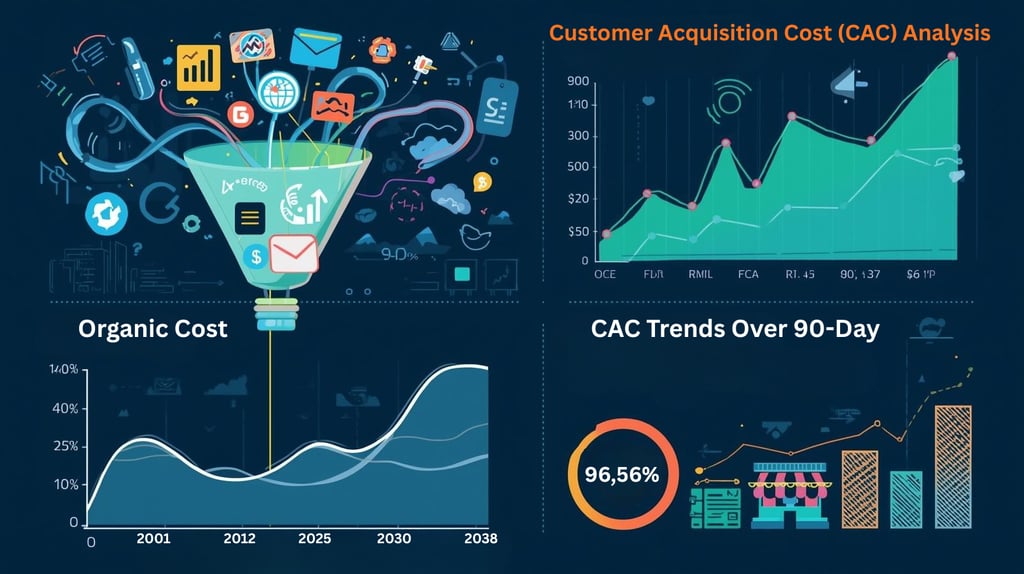Stop Scrolling, Start Creating ⚡ Visit Our Digital Store Now!
How to Calculate Your Real Customer Acquisition Cost
Learn how to calculate your real customer acquisition cost with step-by-step formulas, worked examples, and spreadsheet templates. Master CAC metrics to grow profitably and optimize marketing spend effectively.
DIGITAL MARKETINGE-COMMERCEAFFILIATE MARKETINGONLINE BUSINESS IDEASFREELANCINGEMAIL MARKETINGSOCIAL MEDIA
Eddy Enoma
10/21/202516 min read
Most Businesses Underestimate CAC by 60%. Here's the Step-by-Step System to Get It Right
Executive Summary
Understanding how to calculate your real customer acquisition cost is the difference between profitable growth and burning cash on ineffective marketing. This guide provides finance and marketing managers with concrete formulas, worked examples, and ready-to-use templates to measure true CAC and make data-driven decisions that actually improve your bottom line.
Definition and Purpose
Real Customer Acquisition Cost (CAC) is the complete, fully loaded expense required to acquire one new paying customer. Unlike simplified calculations that only count advertising spend, real CAC captures every dollar that flows toward customer acquisition including marketing spend, sales commissions, team salaries, tools, discounts, and hidden costs most businesses overlook.
The purpose of measuring real customer acquisition cost goes beyond simple accounting. When you know your actual CAC, you can make confident decisions about which channels to scale, which campaigns to cut, and whether your business model is fundamentally sustainable. You can forecast cash flow needs accurately. You can set realistic growth targets. You can negotiate from a position of strength when investors ask about unit economics.
Here's why measuring "real" CAC differs dramatically from the simple spend divided by new customers ratio. The basic CAC formula that only counts ad spend ignores 40 to 60 percent of your actual acquisition costs. You're missing sales team salaries, onboarding discounts, free trial costs, agency retainers, marketing tools, and the portion of executive time spent on growth strategy.
According to recent industry benchmarks, SaaS companies that properly account for all acquisition costs discover their actual CAC is 1.8x higher than initially calculated. E-commerce brands often underestimate by 2.1x when they exclude fulfillment costs, return rates, and promotional discounts tied to first purchases. About 73 percent of startups miscalculate CAC by excluding sales and marketing salaries. Companies that track real CAC grow 2.3x faster than those using simplified metrics.
Most importantly, real CAC reveals whether you're building a business or subsidizing a hobby. If your CAC exceeds customer lifetime value, you're losing money on every sale regardless of how good your top-line revenue looks.
Tools like GetResponse help businesses track these metrics accurately by consolidating data from multiple sources, making it easier to see your complete acquisition picture without jumping between ten different dashboards.
Required Inputs
Before you can calculate your real customer acquisition cost, you need to gather specific data points. Missing even one category will throw off your entire calculation and lead you to make decisions based on incomplete information.
Time Window Selection
Choose your analysis window, whether that's monthly, quarterly, or a custom date range that makes sense for your business. The critical part is matching your spend dates to customer acquisition dates, not close dates. You also need to account for lag time between ad impression and conversion, which typically runs 7 to 30 days depending on your industry.
Your calculation window should match your typical sales cycle length. Short sales cycles under 7 days work well with monthly calculations. Medium cycles from 7 to 45 days benefit from 60 to 90 day windows. Long cycles over 45 days need quarterly analysis to prevent distortion from timing mismatches.
Always align spend dates with the cohort's acquisition month, not when leads entered your funnel. If you spent money in March, but customers converted in April, attribute that spend to April.
Marketing Spend Components
You need paid advertising spend broken down by platform including Google Ads, Facebook, LinkedIn, TikTok, and any display networks. Get channel-specific budgets broken down individually. Don't forget ad creative production costs from designers, copywriters, and video producers. Agency retainers and consulting fees go in here too.
Your marketing automation tools matter, whether that's GetResponse, email platforms, or CRM systems. Content creation expenses for blog posts, videos, and podcasts need to be captured. PR and influencer partnership costs count, as do event sponsorships and trade show expenses.
Sales-Related Costs
Sales team base salaries and commissions for both full-time employees and contractors need tracking. Sales enablement tools like dialers, proposal software, and calendaring systems add up quickly. Demo and presentation software subscriptions go here, along with sales training and coaching expenses.
Operational Overhead
Calculate what percentage of executive time is allocated to growth activities. Marketing team salaries need to include the full burden with benefits, not just base pay. Office space allocated to growth teams costs money. Technology infrastructure supporting acquisition needs to be accounted for.
Customer-Facing Acquisition Costs
First-purchase discounts and promotional codes directly reduce your margins. Free trial costs including product delivery and server resources are real expenses. Free shipping on first orders cuts into profitability. Onboarding white-glove service costs money. Money-back guarantee refunds for new customers and activation incentives like bonus credits or gift cards all need tracking.
Tracking and Attribution
Multi-touch attribution platform costs, analytics and reporting tool subscriptions, conversion tracking setup and maintenance, plus data warehouse and BI tool expenses all enable you to see what's happening with your acquisition funnel.
For businesses with longer consideration periods, Virly can help track LinkedIn prospects through extended nurture cycles, ensuring you capture the full customer journey from first touch to closed deal.
Core Formulas
Let's get into the actual formulas you need to calculate your real customer acquisition cost. These aren't complicated, but you need to use them consistently.
Primary CAC Formula
Real CAC = Total Acquisition Cost ÷ New Paying Customers
Where Total Acquisition Cost includes:
Marketing Spend
Sales Costs
Marketing Salaries & Overhead
Acquisition Tools & Software
Creative & Agency Costs
Customer Incentives & Discounts
Attribution & Analytics Costs
Single-Period CAC (Blended)
Monthly Blended CAC = (All Marketing + Sales Costs for Month) ÷ Total New Customers That Month
Example: Total costs in March hit $45,000. You acquired 150 new paying customers. Blended CAC = $45,000 ÷ 150 = $300 per customer.
Cohort CAC
Cohort CAC = (Total Acquisition Costs During Cohort Month) ÷ Customers Acquired in That Month
This lets you compare March acquirers versus April acquirers over their lifetime, revealing which month's marketing drove better long-term value.
Channel-Specific CAC
Channel CAC = (Channel Spend + Allocated Overhead) ÷ New Customers from That Channel
Example: Google Ads spend $15,000. Allocated creative and salary $3,000. Got 45 new customers. Google Ads CAC = ($15,000 + $3,000) ÷ 45 = $400 per customer.
CAC Per Paying Customer vs. Per Lead
CAC Per Lead = Total Acquisition Cost ÷ Total New Leads CAC Per Paying Customer = Total Acquisition Cost ÷ New Paying Customers Only
If your lead-to-customer conversion rate is 20%, your CAC per paying customer will be 5x your CAC per lead.
Incorporating Refunds and Discounts
Adjusted CAC = (Total Acquisition Cost + First-Purchase Discounts + Refunds Within 30 Days) ÷ (Gross New Customers - Refunded Customers)
Exclude refunded customers from your denominator since they never became real customers.
Including Onboarding Costs
True CAC = Standard CAC + (Onboarding Labor Cost per Customer)
If your customer success team spends 3 hours onboarding each customer at $75/hour, add $225 to your CAC.
Platforms like Chatbase.co can automate some onboarding questions and reduce these labor costs significantly.
Step-by-Step Calculation Process
Follow these steps to calculate your real customer acquisition cost accurately every single time.
Step 1: Define Your Time Window
Choose a consistent period that matches your sales cycle. For most businesses, monthly or quarterly windows work best. Document your chosen window so all team members calculate consistently.
Step 2: Gather All Cost Data
Pull financial data from your advertising platforms (Google Ads, Facebook Ads Manager, LinkedIn Campaign Manager). Get information from your accounting system covering payroll, contractor payments, and subscriptions. Grab expense reports showing agency invoices and tool subscriptions. Check your e-commerce platform for discount codes and refund totals. Look at your CRM system for new customer counts and acquisition dates.
Rewardful can help automate data collection from multiple sources.
Step 3: Cleanse and Normalize Data
Remove duplicate charges. Exclude refunded transactions from your customer count. Adjust for timing differences. Remove customers who refunded within 30 days. Exclude non-acquisition marketing spend like retention campaigns. Adjust for prepaid annual contracts by amortizing over 12 months.
Step 4: Categorize Costs by Type
Organize expenses into direct advertising spend, sales compensation, marketing team costs, tools and software, creative and agency work, customer incentives, and overhead allocation.
Step 5: Choose Your Attribution Model
Last-click attribution gives credit to the final touchpoint. It's simple to implement. Multi-touch attribution distributes credit across all touchpoints. Common models include linear (equal credit), time-decay (more credit to recent), U-shaped (most credit to first and last touch), and W-shaped (credit to first, middle, and last).
Start with last-click for simplicity. Upgrade to multi-touch once you have 6+ months of data. Tools like Impact offer sophisticated attribution tracking.
Step 6: Handle Cross-Channel Overlap
Use primary attribution (credit only the most influential channel), fractional attribution (split the customer across channels), or full attribution (count for each channel but inflates totals). Pick one method and stick with it.
Step 7: Calculate Channel CAC
For each marketing channel: Channel Total Spend + Allocated Shared Costs = Channel Total Cost. Channel Total Cost ÷ Customers from Channel = Channel CAC.
Step 8: Calculate Blended CAC
Sum of All Acquisition Costs ÷ Total New Paying Customers = Blended CAC.
Step 9: Validate and Sense-Check
Is CAC lower than average customer lifetime value? Do high-volume channels show reasonable CAC? Are there obvious data errors? Does CAC trend match business reality?
Step 10: Document and Report
Create a standard report showing blended CAC (current period), channel-specific CAC, period-over-period change, CAC trend (last 6-12 months), and CAC-to-LTV ratio.
Gamma can help create visually compelling reports that executives actually read.
Worked Numeric Examples
Let's walk through real calculations so you can see exactly how the math works.
Example 1: Simple Total CAC Calculation
SaaS Company - March 2025 Data:
Google Ads: $12,000
Facebook Ads: $8,000
LinkedIn Ads: $5,000
Sales team salaries (2 reps): $10,000
Marketing manager salary: $6,000
CRM and tools: $1,200
Agency retainer: $4,000
First-month discounts: $2,400
New paying customers: 80
Calculation:
Total Acquisition Cost = $12,000 + $8,000 + $5,000 + $10,000 + $6,000 + $1,200 + $4,000 + $2,400 = $48,600
Real CAC = $48,600 ÷ 80 = $607.50 per customer
Comparison: If this company only counted ad spend ($25,000), they would calculate CAC at $312.50, missing 48% of actual costs.
Example 2: Channel-Level CAC
Using the same business, calculate CAC by channel with proper overhead allocation.
Channel Attribution:
Google Ads: 35 customers
Facebook Ads: 28 customers
LinkedIn Ads: 17 customers
Overhead to Allocate: $23,600 (sales, marketing salary, tools, agency, discounts)
Allocation Method: Proportional to ad spend
Total ad spend: $25,000
Google: 48% ($12,000 ÷ $25,000)
Facebook: 32%
LinkedIn: 20%
Google Ads CAC: Direct spend: $12,000 + Allocated overhead: $11,328 = $23,328 $23,328 ÷ 35 customers = $666.51
Facebook Ads CAC: Direct spend: $8,000 + Allocated overhead: $7,552 = $15,552 $15,552 ÷ 28 customers = $555.43
LinkedIn Ads CAC: Direct spend: $5,000 + Allocated overhead: $4,720 = $9,720 $9,720 ÷ 17 customers = $571.76
Insight: Facebook delivers the lowest CAC despite medium volume. Google has highest volume but also highest cost per customer.
Example 3: Cohort CAC with Refunds
E-commerce Brand - April 2025:
Total acquisition costs: $62,000
Gross new customers: 310
Customers who refunded within 30 days: 18
Net retained customers: 292
Without Refund Adjustment: $62,000 ÷ 310 = $200.00
With Refund Adjustment: $62,000 ÷ 292 = $212.33
The real CAC is 6.2% higher when you exclude customers who never stuck around.
Example 4: CAC Per Paying Customer vs. Per Lead
B2B Service Business - Q1 2025:
Total acquisition costs: $180,000
Total leads generated: 2,400
Paying customers: 120
Conversion rate: 5%
CAC Per Lead: $180,000 ÷ 2,400 = $75
CAC Per Paying Customer: $180,000 ÷ 120 = $1,500
The real economic cost is $1,500 per customer, not $75. Using A/B Testing AI to improve conversion from 5% to 7% would drop CAC to $1,071.43, a 29% improvement without spending more on ads.
Spreadsheet-Ready Template
Copy this table into Excel, Google Sheets, or any CSV editor. Replace example values with your actual data.
To use this template: create a new tab for each quarter, update weekly or monthly with actual spend, use formulas to auto-calculate CAC columns, create pivot tables to analyze trends, and share with finance teams monthly.
Thunderbit can pull data from multiple sources automatically, saving hours of manual work each month.
Advanced Adjustments and Alternatives
Once you've mastered basic CAC, these advanced techniques help you handle edge cases and get more accurate numbers.
Handling Long Sales Cycles
When sales cycles extend beyond your calculation period, use spend-date attribution. Credit costs to the month when the customer converts, not when you spent the money. A practical shortcut uses a rolling 90-day window for B2B or high-consideration purchases.
Amortizing Large One-Time Expenses
Don't let one-time costs skew monthly CAC. If you pay a $30,000 agency retainer in January for six months of service, allocate $5,000 per month. The same logic applies to annual software subscriptions, website redesigns, and trade show investments.
CAC Payback Period
How long until a new customer's revenue covers their acquisition cost?
CAC Payback Period (Months) = CAC ÷ (Average Monthly Revenue × Gross Margin %)
Example: CAC $600, Monthly subscription $100, Gross margin 80%, Monthly gross profit $80. Payback = $600 ÷ $80 = 7.5 months.
Benchmarks: SaaS under 12 months, E-commerce under 6 months.
LTV to CAC Ratio
LTV:CAC Ratio = Customer Lifetime Value ÷ CAC LTV = (Average Monthly Revenue × Gross Margin %) × Average Lifespan in Months
Example: Monthly revenue $100, Gross margin 75%, Lifespan 24 months. LTV = ($100 × 0.75) × 24 = $1,800. CAC $600. Ratio = 3:1.
Benchmarks:
Under 1:1 - Losing money
1:1 to 2:1 - Barely sustainable
3:1 to 4:1 - Healthy (target zone)
Over 5:1 - Underinvesting in growth
Rewardful can help improve LTV through referral programs, effectively reducing CAC while increasing customer lifetime value.
Cohort and Retention-Aware CAC
Quality-Adjusted CAC = Standard CAC × (Baseline Retention ÷ Cohort Retention)
Example: March CAC $500, March cohort 6-month retention 60%, Company baseline 75%. Quality-adjusted CAC = $500 × (0.75 ÷ 0.60) = $625. March customers are effectively more expensive because they churn faster.
Trial-to-Paid Conversion Impact
For freemium or free-trial businesses:
Trial CAC = Total Cost ÷ Trial Signups Paid CAC = Total Cost ÷ Paying Customers Conversion-Adjusted CAC = Trial CAC ÷ Trial-to-Paid Conversion Rate
Tidio AI Agent can boost conversion rates and effectively reduce CAC without cutting ad spend.
Channel Attribution and Granularity Recommendations
Which Channels to Track Separately
Always track independently: paid search (Google, Bing), paid social (Facebook, Instagram, LinkedIn, TikTok), display advertising, email marketing (acquisition only), affiliate programs, content marketing/SEO, referral programs, and direct sales outreach.
When to Combine Channels
Combine small experimental channels under $1,000/month spend, similar platforms with identical targeting (Instagram + Facebook as "Meta Ads"), and low-volume channels with insufficient conversion data.
When to Split Channels Further
Split when monthly spend exceeds $10,000, you're running distinctly different campaigns (brand vs. performance), conversion rates vary significantly by campaign type, or you need granular optimization data.
Minimum Sample Sizes
Don't make decisions on insufficient data. You need 30 customers per period minimum for directional guidance, 100 for confident decisions. Minimum spend $5,000 per channel per period. Evaluation window of at least 3 months before major changes.
If a channel shows amazing $50 CAC but only delivered 3 customers last month, you need more data. PipiAds can help you research successful ad creatives before launching new channels.
Common Pitfalls and How to Avoid Them
Pitfall 1: Excluding Sales Team Costs
The Mistake: Only counting marketing spend, forgetting sales salaries, commissions, and tools.
The Impact: CAC appears 30-50% lower than reality. You think you're profitable when losing money.
The Fix: Always include full sales compensation, sales tools (CRM, email sequencing), sales training, and percentage of sales leadership time.
Pitfall 2: Mismatched Time Windows
The Mistake: Comparing ad spend from January to customers acquired in March, or using close dates instead of acquisition dates.
The Impact: CAC swings wildly month to month, making trends impossible to spot.
The Fix: Use consistent attribution windows. Credit spend to customer acquisition date, not lead date. Document your window choice and stick with it for 12+ months.
Pitfall 3: Ignoring Refunds and Cancellations
The Mistake: Counting every customer who pays once, even if they refund within days.
The Impact: CAC looks great but retention is terrible. You're acquiring customers who never deliver value.
The Fix: Remove customers who refund within 30 days from your count. Add refund costs to total acquisition spend. Track "qualified CAC" (customers who stay 90+ days) separately.
Pitfall 4: Missing Hidden Marketing Costs
The Mistake: Tracking Google Ads but forgetting landing page software ($3,000/month), attribution tool ($500/month), and freelance designer.
The Impact: Dramatically underestimate true CAC and make incorrect scaling decisions.
The Fix: Create comprehensive cost checklist including all platforms, tools, CRM, analytics, design, agencies, content creation, and hosting. Adcreative AI can reduce creative production costs while maintaining quality.
Pitfall 5: Not Allocating Overhead Properly
The Mistake: Forgetting executive time, office space, and operational overhead supporting acquisition.
The Impact: CAC understates true economics by 10-20%, making marginal channels look profitable.
The Fix: Calculate what percentage of your business focuses on acquisition (typically 20-40%). Apply that to executive salaries, rent, insurance, general overhead. Review quarterly.
Pitfall 6: Treating All Customers Equally
The Mistake: One blended CAC across all segments when enterprise costs $2,000 and SMB costs $200 to acquire.
The Impact: Can't make smart investment decisions. Might kill profitable channels.
The Fix: Segment CAC by customer tier (enterprise, mid-market, SMB, consumer), acquisition channel, geography, and cohort.
Actionable Next Steps and Reporting Checklist
Week 1: Data Inventory
List all systems where acquisition costs live. Identify who owns each data source. Document current access levels and export capabilities. Calculate your current simple CAC as baseline.
Week 2: Build Your Template
Copy the spreadsheet template from this guide. Customize columns for your specific channels and cost categories. Create formulas for automatic CAC calculations. Pull 3 months of historical data to establish baseline trends.
Week 3: Calculate Real CAC
Gather all cost data for your most recent complete month. Include every cost category without skipping overhead. Calculate blended CAC and channel-specific CAC. Compare to your simple CAC baseline (expect real CAC to be 1.5-2x higher).
Week 4: Share and Standardize
Present findings to leadership. Document your calculation methodology. Assign ownership for monthly CAC reporting. Set target CAC goals by channel based on LTV and payback period requirements.
Ongoing Reporting Structure
Weekly: Ad spend by channel, new customer count, quick CAC calculation
Monthly: Complete real CAC calculation with all costs, channel-specific CAC, month-over-month trends, CAC-to-LTV ratio, payback period
Quarterly: Cohort retention analysis, full P&L impact, channel mix optimization recommendations, CAC forecast for next quarter, budget reallocation
Essential KPIs to Monitor Alongside CAC
Customer Lifetime Value (tells if CAC is sustainable), Payback Period (shows time to break even), Monthly Recurring Revenue or Average Order Value (shows if customer value is growing), Retention Rate by Cohort (reveals if quality is improving), Conversion Rate from Lead to Customer (impacts CAC directly), and Channel-Specific Conversion Rates (shows where to optimize).
GetResponse can track email marketing CAC. Metricool consolidates social media metrics across platforms.
Create a monthly CAC review meeting at the same time each month. Invite marketing leadership, sales leadership, finance, and executives. Review numbers, discuss trends, identify opportunities, and make budget allocation decisions.
Build dashboards that update automatically. Connect data sources to visualization tools that refresh daily or weekly. Set up alerts when CAC exceeds thresholds. Share dashboard access with relevant team members. Document everything including your methodology, attribution model, cost categories, and adjustments.
Short FAQ
What if I have multi-touch attribution and customers interact with several channels before converting?
Use a weighted attribution model distributing credit across touchpoints. Start simple with linear attribution (equal credit). Upgrade to time-decay or position-based models once you have more data. Pick one model and stick with it. Platforms like Impact handle this automatically.
How do I handle organic leads that don't have direct acquisition costs?
Organic still has costs. Include content creation, SEO tools, content team salaries, and website hosting. Calculate organic CAC the same way as paid channels. Many wrongly assume organic is free, but you're paying through time and resources.
Should I calculate CAC differently for SaaS versus e-commerce versus service businesses?
Core formula stays the same, but emphasis shifts. SaaS should focus on cohort analysis and payback period. E-commerce needs to include shipping costs, return rates, and first-order discounts. Service businesses should account for sales cycle length and proposal costs.
What time period should I use if my sales cycle is 90 days?
Match your calculation window to sales cycle length. For 90-day cycles, use quarterly CAC or a rolling 90-day window that updates monthly. Never use monthly CAC when your cycle is quarterly.
How often should I recalculate and review CAC metrics?
Calculate monthly for operational tracking. Review trends quarterly for strategic planning. Do deep cohort analysis twice per year. Update CAC targets annually based on goals and market conditions.
Final Summary and Three Improvement Tips
Understanding how to calculate your real customer acquisition cost transforms growth decisions, turning guesswork into data-driven strategy that improves profitability.
Three Tips to Reduce CAC Starting Today
Tip 1: Improve Conversion Rates at Every Funnel Stage
This drops CAC without spending more on ads. Test landing pages, optimize onboarding, improve trial-to-paid conversion, reduce signup friction. A/B Testing AI makes this faster by automating test creation. Even improving from 2% to 3% conversion cuts CAC by 33%.
Tip 2: Focus Spending on Most Efficient Channels
Ruthlessly cut underperformers. Your channel-level CAC shows exactly where to allocate budget. If Facebook delivers $400 CAC and LinkedIn $800, shift budget to Facebook until efficiency drops. Most businesses waste 30-40% of budget on channels that will never deliver positive ROI.
Tip 3: Improve Customer Lifetime Value
This makes higher CAC sustainable. Increase average order value, reduce churn, add upsells, build referral programs. Rewardful helps create referral programs that turn customers into acquisition channels with near-zero CAC. When LTV doubles, you can afford to spend twice as much on acquisition while maintaining profitability.
Conclusion: From CAC Calculation to Sustainable Growth
Calculating your real customer acquisition cost isn't just accounting. It's the foundation of every smart growth decision you'll make. When you know exactly what it costs to acquire a customer, you can confidently invest in channels that work, cut spending on channels that don't, and build a business that scales profitably instead of burning cash.
The difference between businesses that thrive and those that struggle often comes down to this one metric. Companies that track real CAC make data-driven decisions. They know which marketing campaigns deliver returns. They understand their unit economics. They can predict cash flow needs months in advance. They scale without constant fear of running out of runway.
You've now got everything you need. The formulas are proven. The templates are ready. The examples show exactly how to apply them. The only thing left is execution. Download the spreadsheet template. Pull your data. Run the numbers. Share them with your team. Make this a regular part of how you run your business.
Remember that CAC is just one part of the growth equation. Once you've nailed down your acquisition costs, the next step is making sure those customers actually stick around. After all, even the most efficient CAC means nothing if customers churn within weeks.
Continue Your Growth Journey
This guide is part of our ongoing series helping founders and growth teams make better strategic decisions. Now that you understand how to calculate your real customer acquisition cost, here are the next steps in building a sustainable, profitable business.
The Retention Playbook: Keeping Customers in Subscription Models
You've spent all this money acquiring customers. Now learn how to keep them. This comprehensive guide covers retention strategies, churn reduction tactics, and the frameworks top subscription businesses use to maximize customer lifetime value. Discover why reducing churn by just 5% can increase profits by 25-95%, and get the exact playbook to make it happen. When you master retention, your CAC becomes far more sustainable because customers stick around long enough to deliver real value.
Building Your First Marketplace: Supply vs. Demand
Marketplace businesses have unique CAC challenges because you're acquiring two customer types: suppliers and buyers. This guide walks you through the chicken-and-egg problem, shows you how to calculate CAC for both sides of your marketplace, and reveals the strategies successful platforms use to balance growth. Learn when to subsidize one side, how to create network effects that reduce CAC over time, and the metrics that matter most.
These three guides work together to give you a complete view of sustainable growth. Calculate your CAC accurately with this guide. Keep those customers with retention strategies from the next article. Scale efficiently if you're building a two-sided marketplace with the third guide.
The businesses winning today aren't necessarily the ones with the best products or the biggest budgets. They're the ones with the clearest understanding of their numbers and the discipline to act on what the data tells them. You've taken the first step by reading this far. Now go implement what you've learned.
Your path to profitable growth starts with knowing your real customer acquisition cost. Everything else builds from there.
Do you want this CAC calculation framework built specifically for SaaS, e-commerce, or another business model? Email me to let me know, and I can customize the examples and recommendations to match your exact situation.
Sign up for the newsletter below to get more insights directly to your inbox!
Subscribe for Exclusive Tips & Updates. Enter Your Email Below!



Get the latest strategies to create, automate, and monetize with AI, content, and digital marketing straight to your inbox!
🔒 We respect your privacy. Your email is safe with us. Unsubscribe anytime.
Address
Sporerweg 16
94234 Viechtach, Germany
Contacts Us
(049) 170 499 6273
Subscribe to our newsletter
© 2025 Onlinebizoffers. All rights reserved.












